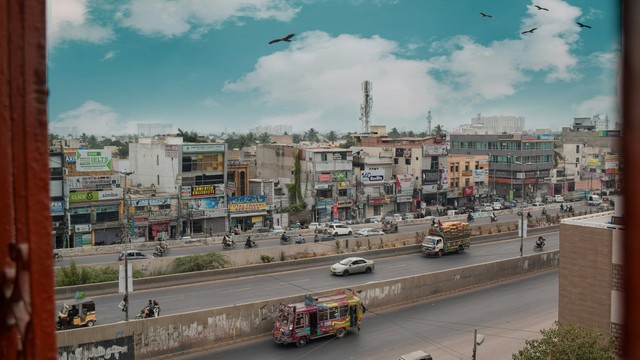Setting the bar too low: is there really progress on UN development goals?
The UN report on progress towards the Millennium Development Goals seems so at odds with realities on the ground, says David Satterthwaite.


There is no government-provided water connection in the Shivaji Nagar slum area of Raipur. Under UN definitions, a household has "improved provision" for water even if it only has access to a public tap or standpipe. (Photo: indiawaterportal.org, Creative Commons via Flickr)
The United Nations claims great progress towards most of the Millennium Development Goals (MDGs). In a report [PDF] published in September, the UN Secretary General, Ban Ki-moon, said the MDGs "have been the most successful global anti-poverty push in history." He added: "Significant and substantial progress has been made in meeting many of the targets—including halving the number of people living in extreme poverty and the proportion of people without sustainable access to improved sources of drinking water. The proportion of urban slum dwellers declined significantly."
But much of the supporting evidence for these claims is based on faulty statistics or heroic guesses where there is no data. I focus on urban areas since this is where I work. It may be that many of the indicators used to monitor MDG performance in rural areas are as inappropriate or inaccurate.
Extreme poverty
The 2013 MDG report says: "The proportion of people living in extreme poverty has been halved at the global level." But this is only because the UN uses an unrealistic poverty line of US$1.25 a day. In most cities, this is not enough to pay for food and non-food needs. If accurate poverty lines were set in each nation based what these things really cost, the proportion of people in extreme poverty would have declined far less than the UN claims.
But set a poverty line low enough and much of the poverty will magically disappear. In applying the US$1.25 poverty line, there appears to be virtually no urban poverty in China, the Middle East, North Africa and Central Asia and very little in Latin America. Why then are hundreds of millions of urban dwellers in these regions — who apparently are not poor — still 'living in poverty' in poor quality, overcrowded homes that lack safe and sufficient water, sanitation, drainage, health care and emergency services? Why are so many of their children malnourished? Is their poverty not 'extreme' enough for the UN to include them in their statistics?
Provision for water
The MDG Report states: "Over 2 billion people gained access to improved sources of drinking water" between 1990 and 2010, and 60 per cent of these were in urban areas. But this was only because the bar is set so low. Under UN definitions, a household has "improved provision" for water even if it only has access to a public tap or standpipe. So someone is said to have improved water even if they share a public tap with hundreds of others. Imagine having to haul 200 litres of water every day from a tap 100 metres from your home. That’s 200 kilos to fetch and carry, often with a long queue and water that flows only intermittently. The UN’s definition of improved water says nothing about whether it is potable. Or available. Or affordable.
‘Slums’
The MDG Report states: "The proportion of slum dwellers in the cities and metropolises of the developing world is declining." It adds that: "Many countries across all regions have shown remarkable progress in reducing the proportion of urban slum dwellers” and that between 2000 and 2010, conditions improved for more than 200 million people so they were no longer living in slums. It even added that "between 2010 and 2012 alone, conditions improved to the point where an additional 44 million people were no longer considered to be living in slums."
But where is the supporting evidence for this? Or for the massive drop in the proportion of India’s urban population living in 'slums' – which the report claims fell from 42 to 29 per cent between 2000 and 2010? The UN statistics also claim very significant falls in the proportion of urban populations living in slums in Bangladesh, Uganda, Angola, and the Democratic Republic of the Congo? How can UN-Habitat, the institution that produces these slum statistics, show changes in slum populations by year? Censuses can reveal detailed data about 'slums' but they take place only every ten years – and many nations have no recent census. Household surveys that may have limited data on 'slums' are also not held each year.
Sanitation
The MDG Report states: "Gains in sanitation are impressive—but not good enough." But here too, the bar is set so low that what is measured has no relation to what people need – a toilet in their home with good provision for disposing of excreta and for washing. A household is said to have ‘improved sanitation’ even if it only has a pit latrine with a slab.
'Urban populations are privileged'
The MDG Report, like so many UN documents, never misses an opportunity to say things are worse in rural areas. But in large part, this is because of the stupidity of setting the same indicators for rural and urban areas. The definition for ‘improved’ water and sanitation is the same for both. So is US$1.25 a day poverty line, as if food and non-food costs were the same. In most urban areas, much of the low-income population must pay a substantial proportion of their income for housing, water and to use toilets. They often have to pay for (very poor quality) schools and health care because as "illegal settlers", they do not quality for publicly funded social services.
The 2013 MDG Report notes other 'rural-urban' gaps — with rural areas having a higher proportion of children out of school and women who lack reproductive health services. But this is misleading. Urban centres concentrate middle and upper-income groups. They are also places where there it is much cheaper per household to provide good quality piped water, sanitation, health care and schools. This emphasis on comparing rural and urban population misses the massive deprivations that many low-income urban citizens face and which the aggregate statistics "for urban populations" hide.
We need a little more honesty and lot more rigour in monitoring the achievement of the MDGs.
Dr David Satterthwaite is the senior fellow in the Human Settlements Group at the International Institute for Environment and Development and the editor of the peer-reviewed journal Environment and Urbanization. He is the co-author, with Diana Mitlin, of Urban Poverty in the Global South: Scale and Nature, published in 2012, and Reducing Urban Poverty in the Global South, published in 2013.
Reference:
United Nations (2013). The Millennium Development Goals Report 2013, United Nations, New York, 60 pages.



